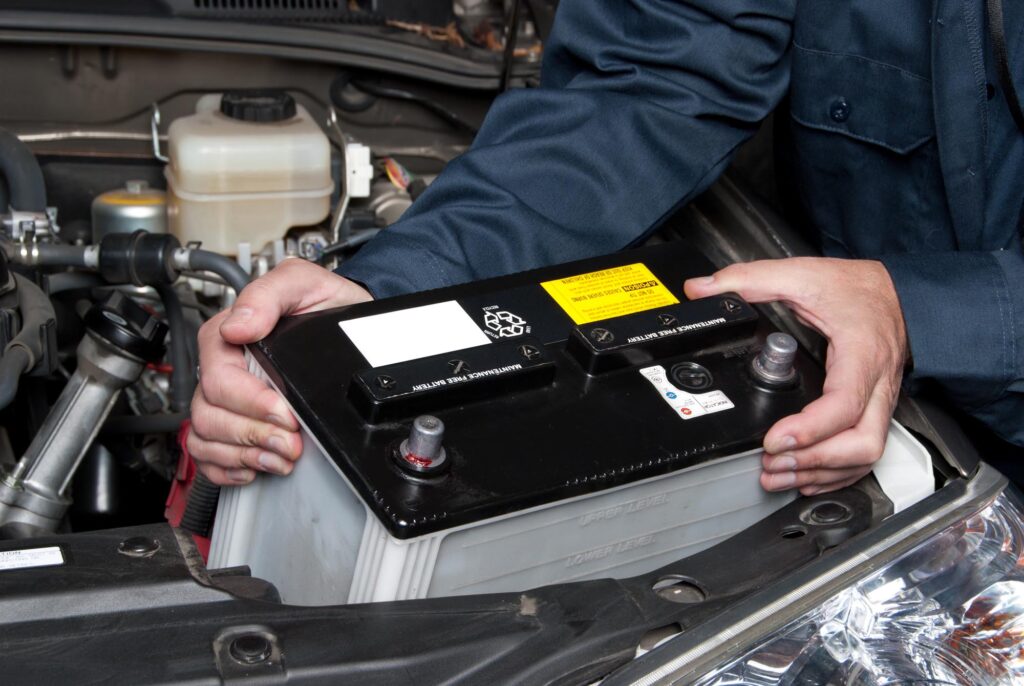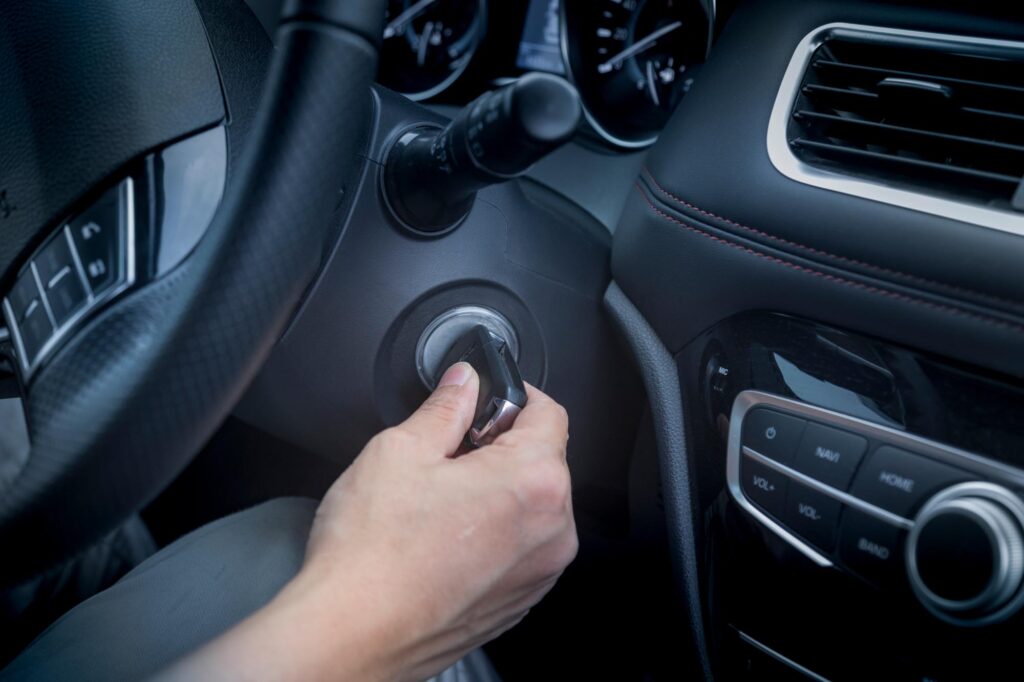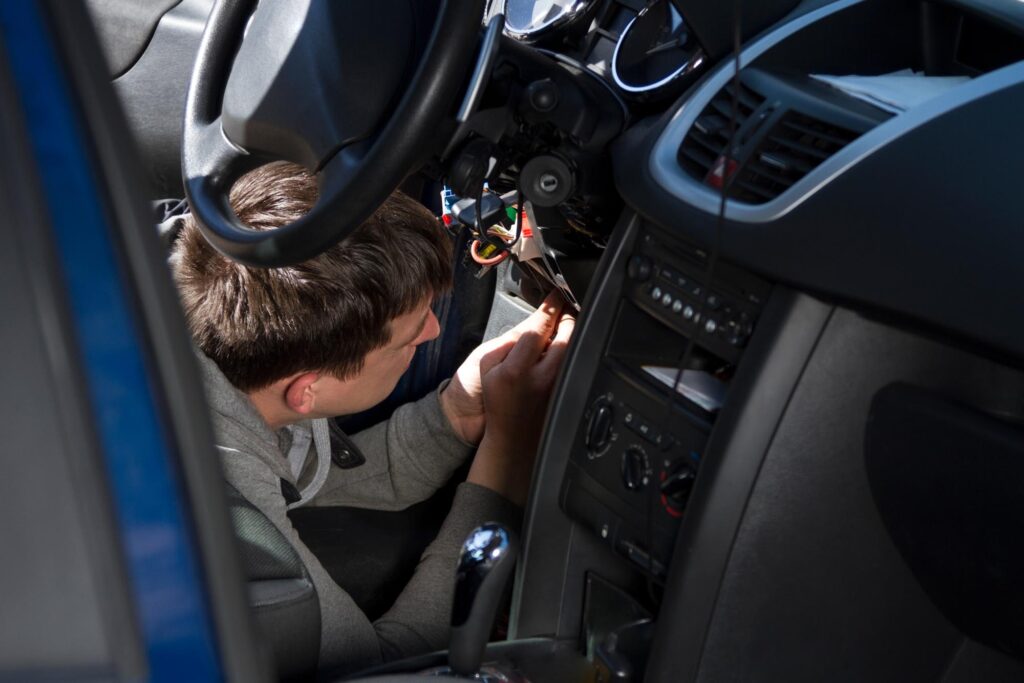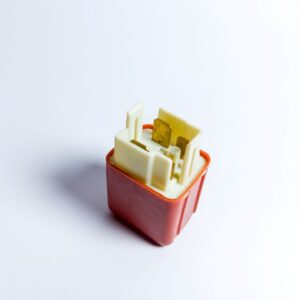Imagine you’ve stepped inside your car, ready to hit the road, only to realize that the ignition switch has no power and the dash lights are dead.
Don’t panic. While it’s nearly impossible to pinpoint the culprit at first glance, knowing the various reasons why this problem can arise can help you get back on the road faster.
Possible Reasons Why There’s No Power to the Dash or Ignition
First, see if anything else might be working, such as the power mirrors and seats, which will typically work even with the key off.
Next, with the key on, try the power windows. If the mirrors and seats work but nothing works with the key on, the diagnostics will be different than if nothing works.
No power to the dash or ignition can be caused by several electrical issues, such as:
Dead or Disconnected Battery
The battery supplies current to every electrical component in your vehicle, including dash lights and ignition parts like the spark plug and ignition coil.

Since the battery provides all the power when you first activate the electrical system, if nothing works, check the battery and its connections, but always wear safety glasses when working around a car battery.
If the battery is completely dead, something on the vehicle drained it. Batteries can self-drain if they’re internally faulty, but that’s not usually what’s wrong.
Take a good look at the cable connections. If you have a test light, see if the battery will light the light. If you have a voltmeter, measure the voltage in the battery.
If the battery is dead, connect a charger or attempt to jumpstart the vehicle with a good set of jumper cables. Make the first connection to the battery positive cable and the final negative connection to the engine block.
If the vehicle starts with the jumper cables connected but dies when you disconnect the jumper cables, the alternator isn’t charging the battery.
If the vehicle stays running after disconnecting the cables and the battery is good but just discharged, simply driving the vehicle for about 30 minutes should restore enough of a charge to the battery to put it back in service. If the battery is bad, it still won’t start the car after driving.
Replacement cost for a defective battery: $70-$1000
Blown Fuse or Fusible Link
Most cars have a large fuse or fuses that feed the underhood junction box and if that big fuse is open, there’s usually a good reason for it. Just replacing the fuse might get you going until the short circuit that blew the fuse to begin with happens again.
Note that in some cases, the replacement fuse can also blow when trying to locate the source of the short circuit.
Replacement cost for a blown fuse: $5-$10
Ignition Switch Problems
Turning on the ignition switch is the first step to activating your vehicle’s electrical systems.

The ignition system takes 12 volts from the battery and converts it to 5,000 to 40,000 volts to jump the gap of the spark plug.
Each cylinder has a spark plug, which ignites the air-fuel mixture in each one. This then creates the pressure that forces the piston down in the cylinder.
An electronic switch in the ICM or powertrain control module (PCM) turns on the primary circuit to charge the coil and eventually cuts off current to let it discharge, generating a high-voltage spark.
But like most electrical components, the ignition switch can fail because of broken springs, worn ignition switch contacts, and temperature problems. Any one of these issues can cut off power to the dash as well.
Replacement cost for a faulty ignition switch: $50-$200
Faulty Alternator
The alternator charges the battery using the principle of electromagnetic induction (converting mechanical energy into electrical energy). So all of your vehicle’s onboard electronics will work only if the alternator does. Of course, if you have replaced a dead battery with a new fully charged battery and the alternator isn’t charging the battery, you can only drive until the battery goes dead. And it will if the alternator isn’t charging.
Replacement cost for a faulty alternator: $100-$1000
Wiring Issues

Loose or broken wires can result in an open circuit, which prevents current from flowing and operating electrical devices. Wire harnesses chafing against sharp edges can cause short or open circuits. A short circuit is when a wire carrying positive current touches the body or engine ground both of which are connected to battery ground. An open circuit is when a wire is completely severed.
An open ground circuit can also cause a total loss of electrical power, so be aware of that as well.
Damaged wiring, also known as electrical shorts, can occur because of excessive movement or heat. Too much vibration can cause the wiring insulation to wear out, while heat can melt the wiring’s protective layer.
Wirings can also get damaged when pinned between heavy objects. Previous accidents and repairs can also lead to similar results.
Replacement cost for damaged wiring: $50-$500
Bad Starter
A bad starter won’t prevent other electrical system components from working, but can itself be bad and prevent the vehicle from starting.
Loose wiring, corroded connections, damaged starter components, oil leaks, and a bad relay or fuse are some of the reasons why a starter can fail.
As the driver turns on the ignition switch, a current for the starter should flow and get the engine running. If not, the starter might be faulty and require replacement.
Aside from having no power at the ignition switch, other symptoms that point to a faulty starter include grinding or whirring noises when cranking the engine.
Replacement cost for a faulty starter: $30-$600
Low Dimmer Switch Settings
If everything else is working but the dash lights don’t work, you might have set the dimmer switch settings to “low.” The dash light dimmer will totally turn the dash lights off if you choose to do that.

But on some vehicles, the dash lights are wired so that if the tail lamp fuse is blown, the dash lights will also be out, so check all the lights if any aren’t working.
The dimmer switch could be a hand-operated lever on the steering column or a spring-loaded switch outside the steering column.
Burnt-Out Dash Bulbs
In some cases, no lights on the dashboard can simply mean that the bulbs are burnt-out due to an excessive current flowing through the circuit. Of course, unless there has been a tremendous surge through the circuit, you won’t find all the dash lights burned out at the same time.
Replacement cost for worn-out dash bulbs: $10-$20
Fixing the Problem
Like most automotive issues, you can resolve electrical problems in your garage, provided that you’re equipped with the right tools and information.
Experienced DIYers might have little to no trouble identifying and fixing the problem on their own. But if you have limited automotive repair knowledge, a trained professional is your best bet to get your vehicle running again.
Keep in mind that tinkering with your vehicle without the right tools and know-how can result in even more issues, which can lead to a more expensive repair bill.
Taking your vehicle to a trusted auto repair shop ensures that all steps and protocols are followed correctly. So you might want to keep that in mind if you ever find yourself in a tight situation with your daily driver.
Getting Replacement Parts to Fix Your Ignition
Restoring your dashboard or ignition’s power supply is only the first step. You’ll have to diagnose and replace the faulty part in order to fully resolve the issue. Luckily, whether it’s a bad battery, blown fuses, or a faulty alternator, you’re sure to find what you need at CarParts.com.
CarParts.com offers a wide selection of aftermarket brands, sourced from only the most trusted manufacturers in the industry. With just a few clicks, you can place an order and get a good deal on a new battery, fuse, or starter. Enjoy a hassle-free shopping experience, thanks to our convenient and secure checkout. Should you need any help, don’t hesitate to reach out to our customer service staff, who offer round-the-clock support.
Replace defective parts before power issues start affecting other parts of your vehicles. Check out our selection of high-quality batteries, fuses, alternators, and starters at CarParts.com, and get one today!
Any information provided on this Website is for informational purposes only and is not intended to replace consultation with a professional mechanic. The accuracy and timeliness of the information may change from the time of publication.































When i hook the bttery up the starter turns doemst start just turns at the sametime i have no power anywhere nothing when the key is on the batt is at 14.5
I have a 2001 Jeep Grand Cherokee Laredo and I took down the headliner and as I was taking down the headliner to replace the drain tubes on my sunroof I had to cut the wires to the center console on the headliner because it was holding up trying to remove the headliner and was tearing up the board of the headliner. Now I don’t have power to anything including a winch that I hooked up directly to the battery. No interior lights nothing happens with the key. There are five wires they are together they come out of the back of that head unit toward the windshield those are the ones that got cut and now nothing works. Help!
Sporadically, I try to start my 1998 Chevy 6-cly PU and there is no power. Then after a few seconds all the power returns and I’m able to start and drive. Batteries are fine. Then it will start without any issues for a few times then it happens again 5 times over the last two months. What could cause this?